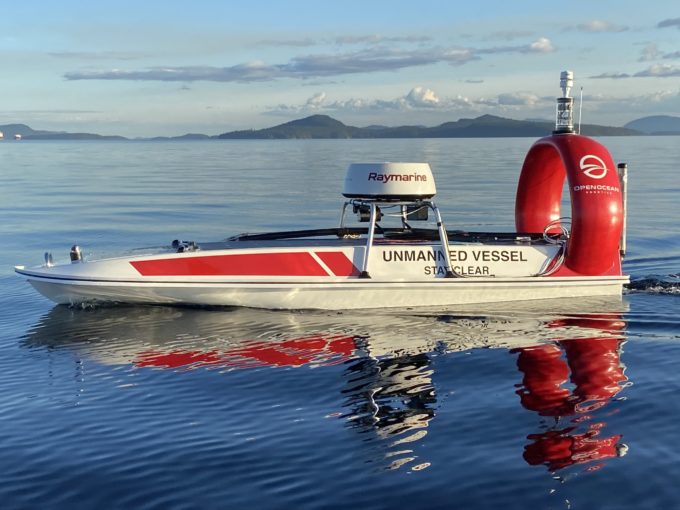This winter, we were proud to celebrate the culmination of the Offshore Wind Challenge—a corporate partnerships accelerator run by Greentown Labs and Vineyard Wind with support from the Massachusetts Clean Energy Center (MassCEC) that advanced innovations in the responsible development of offshore wind.
The Offshore Wind Challenge focused on marine mammal monitoring, specifically for data collection and real-time transmission or data analysis. Over the course of six months, the participating companies—Open Ocean Robotics, Night Vision Technology Solutions, and SICDRONE—worked with the program partners to receive extensive mentoring, business training, and access to resources to advance their technological and commercial development, working toward mutually agreed upon goals in cooperation with Vineyard Wind.
At the program’s Final Showcase, the cohort presented their progress, work with Vineyard Wind, and plans for the future. We were also honored to have Massachusetts State Senator Marc Pacheco join us and share his wisdom on the offshore wind industry and climate policy.
Read more about the participants’ progress below, and check out a recording of the Final Showcase here!
Open Ocean Robotics
Technology at a glance: Open Ocean Robotics makes it cheaper, easier, and safer to understand our oceans using solar-powered, self-driving boats that travel oceans for months at a time while collecting ocean data. Read more about their technology here.
Progress during the Offshore Wind Challenge: Open Ocean Robotics ran six ocean trials, totaling 10 days on the water, with the help of Vineyard Wind and marine mammal scientists. These trials focused on understanding and minimizing the self-noise of the Open Ocean Robotics vessel, testing its sound data against established standards, endurance and sea state testing, and whale detection using acoustics. Open Ocean Robotics found that its boats are quiet, easy to control, and capable of withstanding stormy waters, and that they provide accurate, real-time alerts for marine mammal detection.
Their experience during the program: “Just as we were listening to whales and they were listening to us, we were listening to our partners,” Open Ocean Robotics CEO Julie Angus said. “I can’t say enough thank yous to Vineyard Wind—they’re an exceptional group who’s provided us with tremendous insights.”
What’s next for Open Ocean Robotics: The team will broaden the oceanographic data it collects with its cameras and oceanographic sensors, optimize its boats’ performance, and advance its detection of North Atlantic right whales to also include using cameras.
Night Vision Technology Solutions (NVTS)
Technology at a glance: NVTS is a high-technology provider of ground and maritime stabilized thermal and visible camera systems designed for offshore wind, search and rescue, threat detection, border patrol, and situational awareness.
Progress during the Offshore Wind Challenge: NVTS built a portable thermal and visible camera system with a proof-of-concept AI processing board to automatically detect surfacing whales. They found that they were able to accurately detect whales with thermal imagery—providing information that could be crucial for offshore wind developers and operators.
Why they joined the Offshore Wind Challenge: “We wanted to gain a deeper understanding of humankind’s impact on whale population, understand the supply chain, protect marine mammal activity during construction, and more,” said Joe Janson, CEO of NVTS.
What’s next for NVTS: NVTS plans to onboard AI-capable, analytic hardware and embedded software to support emerging whale detection machine learning algorithms. Future long-range camera systems will come with a rugged touch screen operating tablet and smaller portable control station, for efficient deployment between vessels and ease of operation for protected species observers.
SICDRONE
Technology at a glance: SICDRONE builds offshore-capable aerial drone systems that can fly in harsh weather conditions, eliminating weather delays for critical inspection and monitoring at sea.
Progress during the Offshore Wind Challenge: As part of the program, SICDRONE received grant support from MassCEC, which enabled flight tests, customizations, equipment, and more. At Greentown, SICRDONE’s team used the machine shop to customize its drone and received flight test support from Vineyard Wind. SICDRONE is also sharing its data with the National Oceanic and Atmospheric Administration (NOAA) and Vineyard Wind to help establish drone regulations for marine mammal monitoring.
Advice they received during the program: “Our Vineyard Wind corporate mentors suggested we find a local football field where we could perform tests, because the markings on the field would be helpful when we were reviewing the footage,” Mackenzie Saitta, who does business development and operations for SICDRONE, said. “We used markings with the head and the tail of the right whale and performed tests using the lines of the football field to help SICRDONE find the optimal angle and altitude for our camera and platform.”
What’s next for SICDRONE: Moving forward, SICDRONE will keep up its R&D efforts with Vineyard Wind and will continue collaborating with NOAA to chart drone regulations for marine mammal monitoring.


